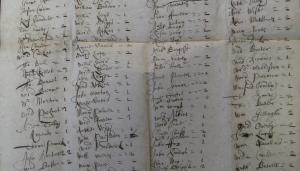London and Middlesex Hearth Tax (1666): an analysis of the status and wealth of neighbourhoods and households on the eve of the Great Fire

The Hearth Tax was a national tax first granted by Parliament in 1662 to support the government of the restored Stuart Monarchy. As was common for most direct taxes before the introduction of Income Tax over a century later, it was a wealth tax, in this instance using the size of house (determined by the number of hearths or fireplaces it contained) as a proxy for the wealth of the household. To implement it, there had to be a nationwide listing or ‘return’ of householders and hearths, by ward or parish, town, and county, regularly updated. Many of these listings survive in The National Archives, Kew, and they provide an important insight into distributions of wealth across the country, as well as allowing modern readers to search for named individuals.
This collaborative project between the Centre for Hearth Tax Research (Roehampton), the CMH and Birkbeck, funded by the AHRC, aimed to edit, analyse and publish, in hard copy and online, the surviving portions of the London and Middlesex returns for Lady Day (25 March) 1666. Returns survive for several different dates, but this was deemed the best choice for editing and publication. Although incomplete, as are all other London returns, it covers most of the city, and it reveals a metropolis poised between two devastating events, the plague of 1665 (which was still afflicting parts of London in the spring of 1666) and the Fire of 2-6 September 1666, which destroyed the greater part of the city within the walls and much of the inner western suburb, making perhaps 75,000 Londoners homeless. Particular virtues of the 1666 returns are that many of them give the occupations as well as the names of householders, and are organised topographically so that the sequence of householders along a street can be reconstructed as in a street directory. However, quite a number of parish returns are missing for Lady Day 1666, so the project team also edited selected returns from 1662/3 in order to cover every parish in metropolitan London and rural Middlesex. The project also listed and in some cases transcribed all the relevant certificates for exemption from the tax – usually granted on grounds of poverty, and therefore contributing to the mapping of social values across the metropolis. London south of the river – almost all within the county of Surrey at this date – was not covered by this project, and as yet no full edition of the Surrey returns is planned.
It is hoped that publication of the returns and an accompanying volume of essays (to be completed by the end of 2011) will stimulate research outside as well as within the material published, so that people will make links with other data sources, and draw comparisons with other areas or cities. An example of the integration of Hearth Tax data into a larger matrix of information is the study ‘People in Place: families, households and housing in early modern London’, an earlier AHRC-funded project co-directed by Professor Vanessa Harding, Professor Matthew Davies, and Professor Richard Smith of the Cambridge Group for the History of Population and Social Structure.
Hearth Tax data online
The London and Middlesex returns can now be viewed via British History Online (see links below). The returns can be browsed by place, so the reader can see who lived in a particular parish or village, how many hearths each householder answered for, and how many houses of different sizes a community contained. For example, the rural village of Hampsted in 1666 contained 188 properties, of which 48 were occupied by poor people. Three householders refused to open their doors to the assessors, and another 45 houses were currently empty, perhaps in the aftermath of the 1665 plague. But Hampstead was already attracting well-to-do second-homers: city alderman Thomas Hussey had a 15-hearth house there. Lord Wotton’s huge 36-hearth house, presumably Belsize Manor, was currently empty, as was a small 4-hearth house he owned, but several other houses with between 10 and 17 hearths were occupied. Alternatively, the reader can search for individuals, though the success of this will depend on whether the person was a householder, and also whether the published returns cover the right date for his or her residence. It should also be possible to locate individuals or groups with distinctive forenames or surnames, such as the Welsh, French Huguenot, Dutch, or Jewish residents of 1660s London – as long as allowances are made for the assessors’ idiosyncratic spellings.
The returns of the Hearth Tax assessment for the City of London in 1662
The returns of the Hearth Tax assessment for the City of Westminster in 1664
The returns of the Hearth Tax assessment for metropolitan London in 1666
All of the above returns, in the form of an expanded, fully queryable Microsoft Access database, can also be downloaded from the School of Advanced Study's e-repository, SAS-Space.
Project details
Database consultant: Mark Merry (CMH)
Directors: Andrew Wareham (Centre for Hearth Tax Research, Roehampton University), Professor Matthew Davies (CMH), and Professor Vanessa Harding (Birkbeck, University of London)
Funded by: The Arts and Humanities Research Council (Award ref: AH/E008445/1) 1 October 2007-30 September 2010
Amount awarded: £87,700
